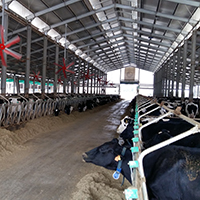Assessing the effect of barns structures and environmental conditions in dairy cattle farms monitored in Northern Italy

Published:23 December 2021
Abstract Views: 1288
PDF: 631
HTML: 17
HTML: 17
Publisher's note
All claims expressed in this article are solely those of the authors and do not necessarily represent those of their affiliated organizations, or those of the publisher, the editors and the reviewers. Any product that may be evaluated in this article or claim that may be made by its manufacturer is not guaranteed or endorsed by the publisher.
All claims expressed in this article are solely those of the authors and do not necessarily represent those of their affiliated organizations, or those of the publisher, the editors and the reviewers. Any product that may be evaluated in this article or claim that may be made by its manufacturer is not guaranteed or endorsed by the publisher.
Similar Articles
- Alessandro D'Emilio, Simona M.C. Porto, Giovanni Cascone, Marco Bella, Marco Gulino, Mitigating heat stress of dairy cows bred in a free-stall barn by sprinkler systems coupled with forced ventilation , Journal of Agricultural Engineering: Vol. 48 No. 4 (2017)
- Simona M.C. Porto, Alessandro D'Emilio, Giovanni Cascone, On the influence of the alternation of two different cooling systems on dairy cow daily activities , Journal of Agricultural Engineering: Vol. 48 No. 1 (2017)
- Enrica Santolini, Marco Bovo, Alberto Barbaresi, Daniele Torreggiani, Patrizia Tassinari, Evaluation of microclimate in dairy farms using different model typologies in computational fluid dynamics analyses , Journal of Agricultural Engineering: Vol. 55 No. 3 (2024)
- Carlos Alejandro Perez Garcia, Marco Bovo, Daniele Torreggiani, Patrizia Tassinari, Stefano Benni, 3D numerical modelling of temperature and humidity index distribution in livestock structures: a cattle-barn case study , Journal of Agricultural Engineering: Vol. 54 No. 3 (2023)
- Lorenzo Leso, Maurizio Uberti, Wasseem Morshed, Matteo Barbari, A survey of Italian compost dairy barns , Journal of Agricultural Engineering: Vol. 44 No. 3 (2013)
- Daniele Torreggiani, Alberto Barbaresi, Francesca Dallacasa, Patrizia Tassinari, Effects of different architectural solutions on the thermal behaviour in an unconditioned rural building. The case of an Italian winery , Journal of Agricultural Engineering: Vol. 49 No. 1 (2018)
- Qazeem Opeyemi Ogunlowo, Adedayo Afeez Azeez, Wook Ho Na, Anis Rabiu, Misbaudeen Aderemi Adesanya, Ezatullah Zakir, John Ademola Ijadunola, Bukola Olanrewaju Afolabi, Babajide Saheed Kosemani, Titus Adeyinka Ilori, Hyun-Woo Lee, Analysis of microclimate temperature and relative humidity distribution of local poultry house in a subtropical area of Nigeria , Journal of Agricultural Engineering: Vol. 55 No. 2 (2024)
- Hui Yang, Yuhao Li, Chengguo Fu, Rongxian Zhang, Haibo Li, Yipeng Feng, Yaqi Zhang, Hongbin Cong, Fuquan Nie, Research on inspection route of hanging environmental robot based on computational fluid dynamics , Journal of Agricultural Engineering: Vol. 55 No. 2 (2024)
- Gabriele Mattachini, Elisabetta Riva, Francesca Perazzolo, Ezio Naldi, Giorgio Provolo, Monitoring feeding behaviour of dairy cows using accelerometers , Journal of Agricultural Engineering: Vol. 47 No. 1 (2016)
- Alvaro Marucci, Danilo Monarca, Massimo Cecchini, Andrea Colantoni, Simone Di Giacinto, Andrea Cappuccini, The heat stress for workers employed in a dairy farm , Journal of Agricultural Engineering: Vol. 44 No. 4 (2013)
You may also start an advanced similarity search for this article.

 https://doi.org/10.4081/jae.2021.1229
https://doi.org/10.4081/jae.2021.1229 











